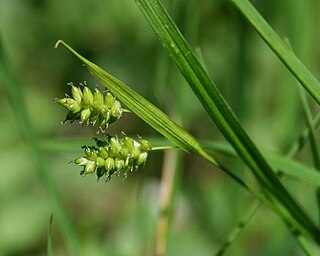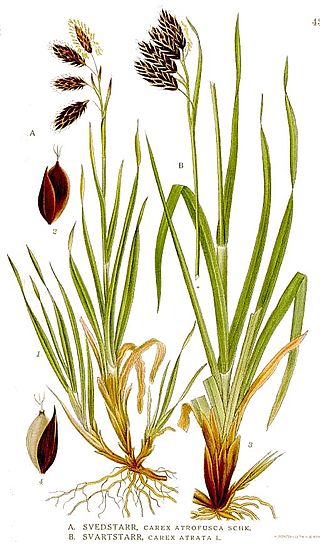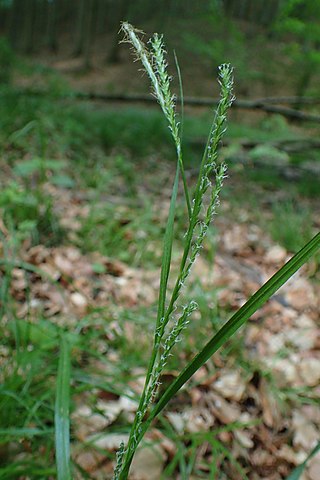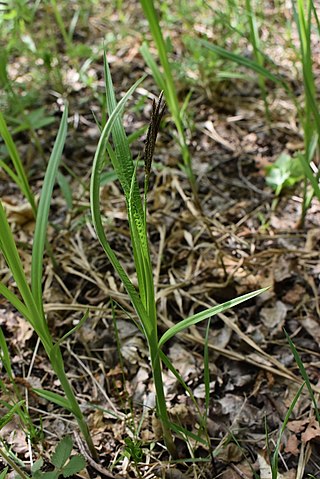
The Cyperaceae are a family of graminoid (grass-like), monocotyledonous flowering plants known as sedges. The family is large, with some 5,500 known species described in about 90 genera, the largest being the "true sedges" genus Carex with over 2,000 species.

Carex is a vast genus of nearly 2,000 species of grass-like plants in the family Cyperaceae, commonly known as sedges. Other members of the family Cyperaceae are also called sedges, however those of genus Carex may be called true sedges, and it is the most species-rich genus in the family. The study of Carex is known as caricology.

Carex lacustris, known as lake sedge, is a tufted grass-like perennial of the sedge family (Cyperaceae), native to southern Canada and the northern United States. C. lacustris us an herbaceous surface-piercing plant that grows in water up to 50 cm (1.6 ft) deep, and grows 50–150 cm (1.6–4.9 ft) tall. It grows well in marshes and swampy woods of the boreal forest, along river and lake shores, in ditches, marshes, swamps, and other wetland habitat. It grows on muck, sedge peat, wet sand or silt, in filtered or full sunlight.

Carex pallescens, called pale sedge, is a widespread species of flowering plant in the genus Carex, native to the northeastern United States, eastern Canada, Iceland, Europe, Tunisia, and western Asia. It has unstable chromosome numbers.

Carex praecox, the spring sedge, is a species of flowering plant in the genus Carex, native to Europe, western Asia, and Mongolia. Its diploid chromosome number is 2n=58, with some uncertainty.

Carex atrata, called black alpine sedge, is a widespread species of flowering plant in the genus Carex, native to Greenland, Iceland, and most of Europe, plus scattered locations across temperate Asia, including Anatolia, Siberia and the Himalaya, as far as Taiwan and Japan. Its chromosome number is 2n=52, with some variants reported, e.g. n2=54 for Greenland material.

Carex strigosa, the thin-spiked wood sedge, is a species of flowering plant in the genus Carex, native to Europe and the Caucasus region. Its diploid chromosome number is 2n=66.

Carex melanostachya, called the Great Plains sedge, is a species of flowering plant in the genus Carex, native to central Europe to western Asia, and introduced to the central US. Its chromosome number is 2n=54, with some uncertainty.

Carex lachenalii, called the twotipped sedge and hare's foot sedge, is a species of flowering plant in the genus Carex, native to temperate and subarctic North America, Greenland, Iceland, Europe, and Asia, and the South Island of New Zealand. Its diploid chromosome number is 2n=64, with some uncertainty.
Carex hordeistichos, called barley sedge, is a species of flowering plant in the genus Carex, native to northwest Africa, southern, central and eastern Europe, and western Asia as far as Iran and Kazakhstan. Its chromosome number is 2n=58, with numerous variants reported.

Carex parviflora, called the small-flowered sedge, is a species of flowering plant in the genus Carex, native to central and southern Europe. Its chromosome number is 2n=54.

Carex punctata, the dotted sedge, is a species of flowering plant in the genus Carex, native to Macaronesia, northwest Africa, southern, central, and northern Europe, and Turkey. Its chromosome number is 2n=68.

Carex elongata, the elongated sedge, is a species of flowering plant in the family Cyperaceae, native to Europe, the Caucasus, western Siberia, Kazakhstan, and the Altai. It occurs in boggy woodland and wet meadows, where it forms dense tussocks up to about 1 m tall.
Carex xiphium is a species of sedge in the family Cyperaceae, native to the Russian Far East, Manchuria, and the Korean Peninsula. Its chromosome number is 2n = 56.

Carex sordida is a species of sedge, native to southern Siberia, Mongolia, Manchuria, the Russian Far East, Korea, and Japan. Its chromosome number is 2n = 100.
Carex riloensis is a species of sedge in the family Cyperaceae, native to the Rhodope Mountains of Bulgaria. Its chromosome number is 2n = 26.
Carex socotrana is a species of sedge in the family Cyperaceae, native to the island of Socotra. It is known from only two populations in the Hajhir Mountains.

Carex feta, the green-sheathed sedge or greensheath sedge, is a species of flowering plant in the family Cyperaceae, native to southwestern British Columbia in Canada, and Washington, Oregon, and California in the United States.
Carex quadriflora, the four-flower sedge, is a species of flowering plant in the family Cyperaceae, native to northeastern China, the Russian Far East, the Korean Peninsula, and Japan. Its chromosome number is 2n = 46.
Carex fritschii is a species of sedge, native to central Europe. Preferring to grow in sandy or gravelly soils in well-lit oak woodlands, its chromosome number is 2n = 30.














